Charadriidae – Plovers, Lapwings & Dotterels
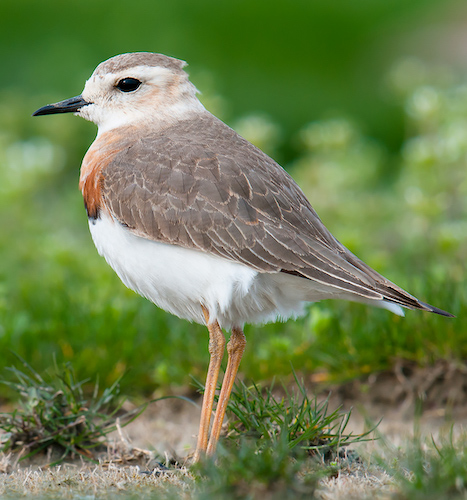
The Charadriidae (Plovers & Lapwings) family is made up of waders that are sufficiently distinctive to merit their own family. The order Charadriiformes also includes Pluvianellidae (Magellanic Plover), Chionidae (Sheathbills), Burhinidae (Thick-knees & Stone Curlews), Pluvianidae (Egyptian Plover), Recurvirostridae (Stilts & Avocets) Ibidorhynchidae (Ibisbill), Haematopodidae (Oystercatchers), Pedionomidae (Plains Wanderer), Thinocoridae (Seedsnipes), Rostratulidae (Painted Snipe), Jacanidae (Jacanas), Scolopacidae (Sandpipers), Turnicidae (Buttonquails), Dromadidae (Crab-Plover), Glareolidae (Coursers & Pratincoles), Stercorariidae (Skuas), Alcidae (Auks) and Laridae (Gulls, Terns & Skimmers).
The Charadriidae bird family includes the plovers, dotterels, and lapwings, about 68 species in all.
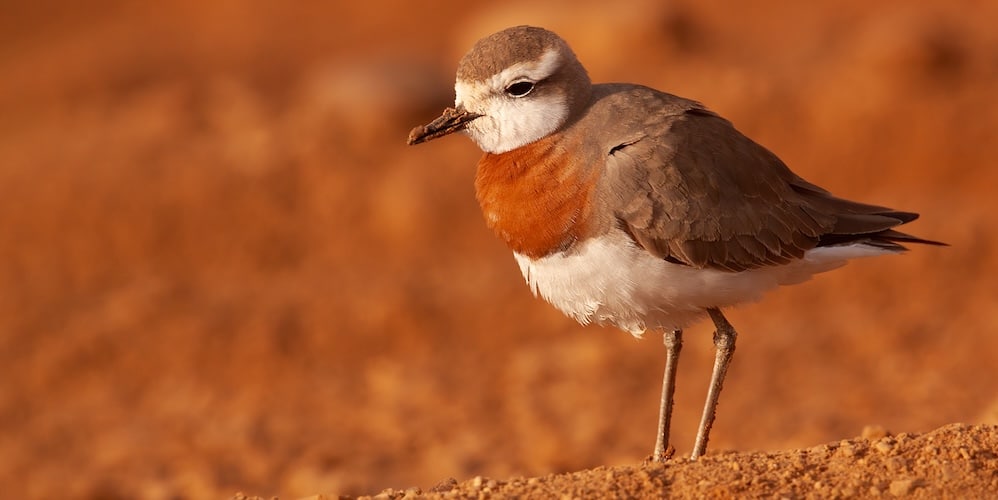
Caspian Plover Anarhynchus asiaticus – ©Dubi Shapiro
They are small to medium-sized birds with compact bodies, short, thick necks and long, usually pointed, wings, but most species of lapwing may have more rounded wings. Their bills are usually straight (except for the Wrybill) and short, their toes are short, their hind toe could be reduced or absent, depending on species. Most Charadriidae also have relatively short tails; the Killdeer is the exception.
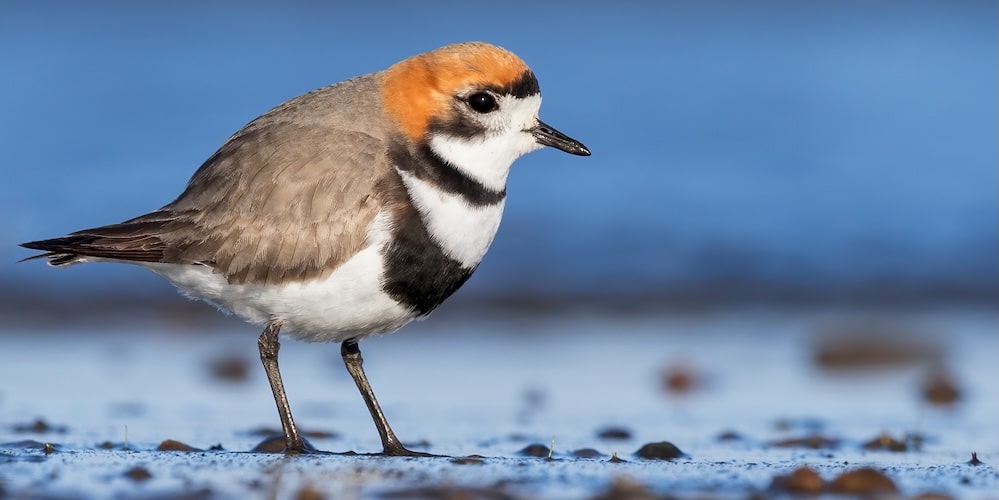
Two-banded Plover Anarhynchus falklandicus – ©Dubi Shapiro
In most genera, very little sexual dimorphism occurs between sexes. They range in size from the Collared Plover, at 26 grams and 14cm, to the Masked Lapwing, at 368 grams and 35cm. They are distributed through open country worldwide, mostly in habitats near water, although there are some exceptions: the Inland Dotterel, for example, prefers stony ground in the deserts of central and western Australia.
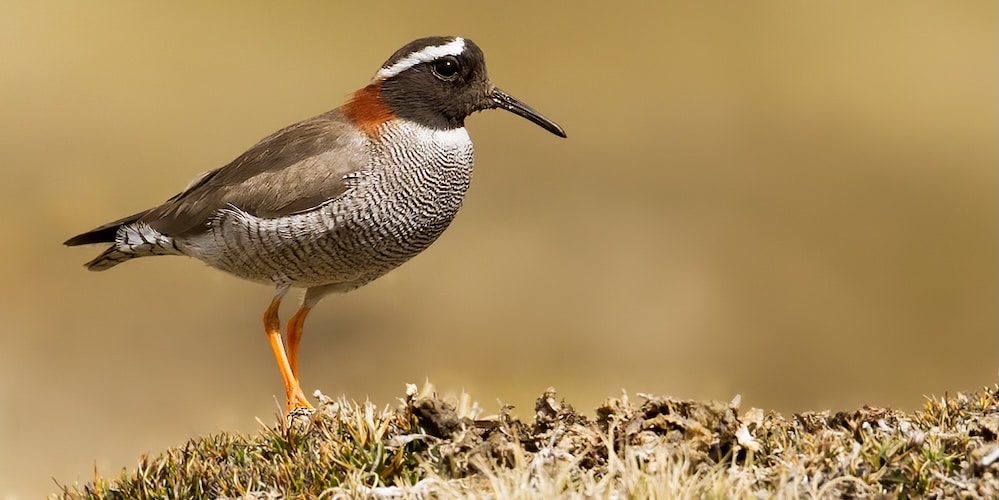
Diademed Sandpiper-Plover Phegornis mitchellii – ©Dubi Shapiro
They hunt by sight, rather than by feel, which is the way longer-billed waders like snipe do. Foods eaten include aquatic and terrestrial invertebrates such as insects, worms, molluscs and crustaceans depending on habitat, and are usually obtained by a run-and-pause technique, rather than the steady probing of some other wader groups. They also feed on plant material.
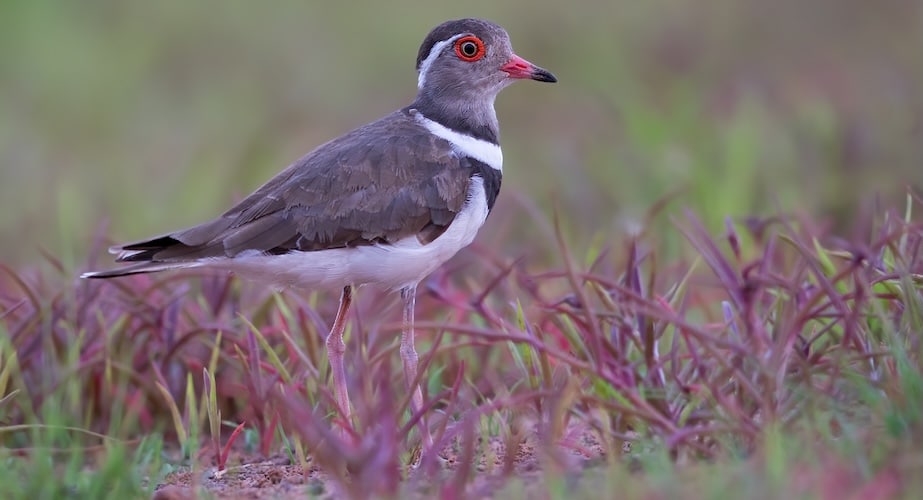
Forbes’s Plover Thinornis forbesi – ©Dubi Shapiro
It has recently been realised that many will even feed at night when the moon is bright; this can account for a significant proportion of their foraging time. They occur throughout the world, from the tideline to mountain meadows. Although classified as waders (and some do occur near water, particularly in the non-breeding season), they are really birds of open grassland.

Three-banded Plover Thinornis tricollaris – ©Bird-Photo-Tours ASIA
The vast majority of Charadriidae have a socially monogamous mating system. Some, such as Northern Lapwings, are polygynous, others, such as Mountain Plovers have a rapid multiple-clutch system that can be accompanied by sequential polyandry. In Eurasian Dotterels, females compete for males and males provide all parental care. While breeding, they defend their territories with highly visible aerial displays.
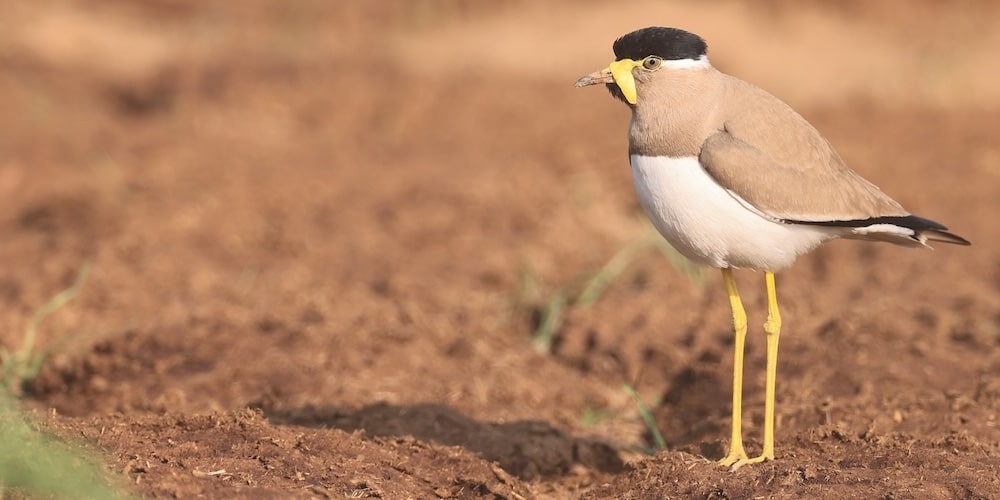
Yellow-wattled Lapwing Vanellus malabaricus – ©Bird-Photo-Tours ASIA
Most plovers lay two to four eggs into the nest, which is usually a shallow scrape in the open ground, and incubate the clutch for 21 to 30 days. In species where both parents incubate the eggs, females and males vary in the way they share their incubation duties, both within and between species. In some pairs, parents exchange on the nest in the morning and in the evening so that their incubation rhythm follows a 24-hour day, in others females and males exchange up to 20 times a day.
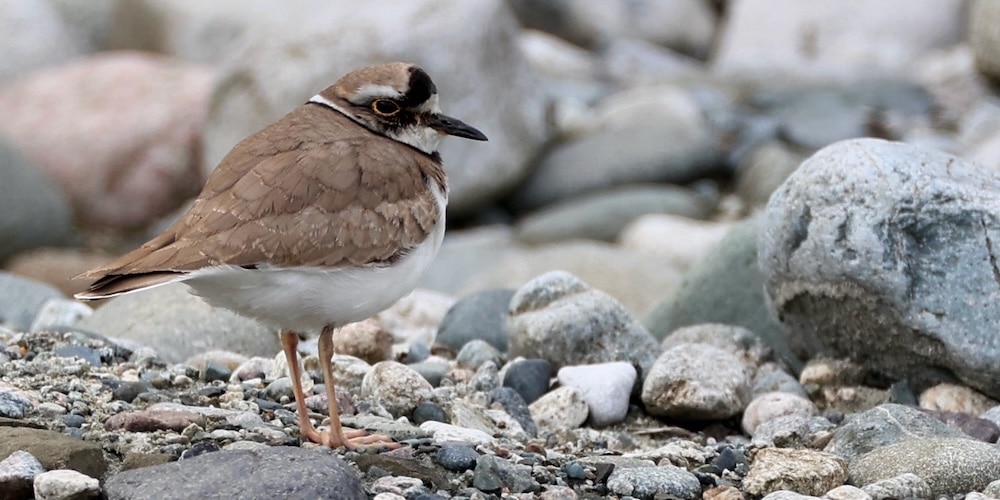
Long-billed Plover Thinornis placidus – ©Bird-Photo-Tours ASIA
They are protective over their eggs and offspring. The parents protect their young by uttering an alarm call, performing distraction display and they may even attack the predator or intruder. The chicks are precocial; their parents do not feed them.
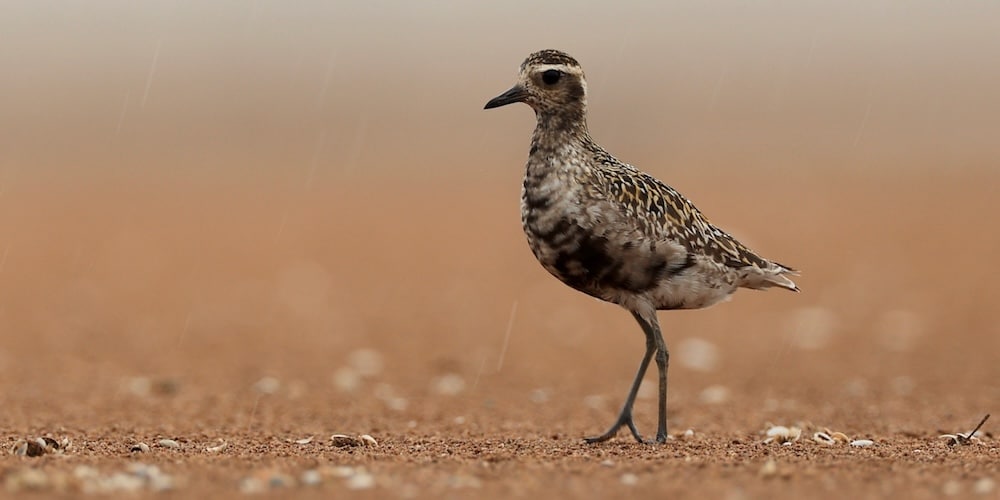
Pacific Golden Plover Pluvialis fulva – ©Bird-Photo-Tours ASIA
The commonest plover in Britain is the Ringed Plover, which breeds on sandy and shingle beaches around the coasts of Britain, though its cryptic colours mean that it can be hard to spot! The Lapwing leads something of a double life, being generally found on inland wet grassland in summer and around our coasts in winter.
-
Number of bird species: 68
(As at September 2025)
There are according to the recently (2025) amalgamated AviList, there 68 extant dotterels, plovers & lapwings. in twelve genera of the Charadriidae family. They are:
Grey Plover Pluvialis squatarola
European Golden Plover Pluvialis apricaria
American Golden Plover Pluvialis dominica
Pacific Golden Plover Pluvialis fulva
Tawny-throated Dotterel Oreopholus ruficollis
Pied Plover Hoploxypterus cayanus
Diademed Sandpiper-Plover Phegornis mitchellii
Rufous-chested Plover Zonibyx modestus
Eurasian Dotterel Eudromius morinellus
Killdeer Charadrius vociferus
Common Ringed Plover Charadrius hiaticula
Semipalmated Plover Charadrius semipalmatus
Piping Plover Charadrius melodus
Hooded Dotterel Thinornis cucullatus
Shore Dotterel Thinornis novaeseelandiae
Black-fronted Dotterel Thinornis melanops
Forbes’s Plover Thinornis forbesi
Three-banded Plover Thinornis tricollaris
Long-billed Plover Thinornis placidus
Little Ringed Plover Thinornis dubius
Northern Lapwing Vanellus vanellus
Long-toed Lapwing Vanellus crassirostris
Blacksmith Lapwing Vanellus armatus
Spur-winged Lapwing Vanellus spinosus
River Lapwing Vanellus duvaucelii
Yellow-wattled Lapwing Vanellus malabaricus
Black-headed Lapwing Vanellus tectus
White-crowned Lapwing Vanellus albiceps
Senegal Lapwing Vanellus lugubris
Black-winged Lapwing Vanellus melanopterus
Crowned Lapwing Vanellus coronatus
African Wattled Lapwing Vanellus senegallus
Spot-breasted Lapwing Vanellus melanocephalus
Brown-chested Lapwing Vanellus superciliosus
Grey-headed Lapwing Vanellus cinereus
Red-wattled Lapwing Vanellus indicus
Javan Lapwing Vanellus macroipterus
Banded Lapwing Vanellus tricolor
Masked Lapwing Vanellus miles
Sociable Lapwing Vanellus gregarius
White-tailed Lapwing Vanellus leucurus
Southern Lapwing Vanellus chilensis
Andean Lapwing Vanellus resplendens
Red-kneed Dotterel Erythrogonys cinctus
Inland Dotterel Peltohyas australis
Caspian Plover Anarhynchus asiaticus
Oriental Plover Anarhynchus veredus
Tibetan Sand Plover Anarhynchus atrifrons
Lesser Sand Plover Anarhynchus mongolus
Greater Sand Plover Anarhynchus leschenaultii
Double-banded Plover Anarhynchus bicinctus
New Zealand Plover Anarhynchus obscurus
Wrybill Anarhynchus frontalis
Wilson’s Plover Anarhynchus wilsonia
Collared Plover Anarhynchus collaris
Mountain Plover Anarhynchus montanus
Two-banded Plover Anarhynchus falklandicus
Puna Plover Anarhynchus alticola
Madagascan Plover Anarhynchus thoracicus
Kittlitz’s Plover Anarhynchus pecuarius
St. Helena Plover Anarhynchus sanctaehelenae
Red-capped Plover Anarhynchus ruficapillus
Snowy Plover Anarhynchus nivosus
Chestnut-banded Plover Anarhynchus pallidus
Malaysian Plover Anarhynchus peronii
White-fronted Plover Anarhynchus marginatus
Javan Plover Anarhynchus javanicus
Kentish Plover Anarhynchus alexandrinus
-
Australasia Wader Study Group
WebsiteThe Australasian Wader Studies Group was formed in 1981 as a special interest group of Birds Australia. The group is an non-government organisation dedicated to studying waders (otherwise known as shorebirds) throughout the East-Asian Australasian Flyway. There are about 330 members, of which 90 are from Asia -
International Wader Study Group
WebsiteThe International Wader Study Group (IWSG) is an association of amateurs and professionals from all parts of the world interested in Charadrii (waders or shorebirds). Membership of the WSG is currently over 650 worldwide. Members can be found in over 50 countries around the world, including all European countries and the Americas, Asia, Africa and Australasia. The interests of the group have diversified from its original focus from ringing and migration-related studies to embrace all aspects of wader biology. -
Western Hemisphere Shorebird Reserve Network
WebsiteConserving shorebirds and their habitat through a network of key sites across the Americas.
-
Geographical Variation in Waders
| By Meinte Engelmoer & Cees S Roselaar | Kluwer Academic Publishers | 1998 | Hardback | 331 pages, figures, tabs, maps | ISBN: 9780792350200 Buy this book from NHBS.com -
The Population Ecology and Conservation of Charadrius Plovers
| Edited by Mark A Colwell & Susan M Haig | CRC Press | 2020 | Paperback | 330 pages, b/w photos, b/w illustrations, tables | ISBN: 9780367729974 Buy this book from NHBS.com -
The Shorebirds of North America - A Natural History and Photographic Celebration
| By Pete Dunne & Kevin T Karlson | PUP | 2024 | Hardback | 294 pages, 225 colour photos | ISBN: 9780691220956 Buy this book from NHBS.com -
Tundra Plovers
| (The Eurasian, Pacific and American Golden Plovers and Grey Plover | by Ingvar Byrkjedal & Des Thompson | T & AD Poyser Ltd (A & C Black) | 2002 | Hardback | 422 pages, 40 photos, illustrations, figures, tables, maps | ISBN: 9780856611094 Buy this book from NHBS.com -
Waders of Europe, Asia & North America
| By Stephen Message & Don Taylor | Helm | 2005 | Paperback | 224 pages, 80 plates with colour illustrations | ISBN: 9780713652901 Buy this book from NHBS.com
-
Charadriidae
Family AccountPlovers and lapwings can be found in almost any open habitat, from desert, open savanna, or alpine tundra (puna in South America) to beaches, golf courses and... -
Charadriidae
Family AccountThe bird family Charadriidae includes the plovers, dotterels, and lapwings. The family contains 69 species that are divided into 10 genera. Charadriidae from en.wikipedia.org Charadrius Vanellus Pluvialis... -
Charadriidae
Family AccountThe plovers and lapwings form a group of morphologically similar birds, all have moderately long legs and relatively large, rounded heads with short, stubby...
Given the number of species in this family, Fatbirder does not provide quick links to all of them. However, the entries below do include links to representatives of every genera, all those illustrated and some of the most often encountered, iconic or sought-after species.
-
American Golden Plover Pluvialis dominica
Species AccountImages, description, full species account… -
American Golden Plover Pluvialis dominica
Species AccountA large shorebird of pastures, open ground, and mudflats, the American Golden-Plover makes one of the longest migratory journeys of any shorebird. -
American Golden Plover Pluvialis dominica
Species AccountPluvialis dominica is listed as Least Concern. -
American Golden Plover Pluvialis dominica
Species AccountSound archive and distribution map. -
Blacksmith Lapwing Vanellus armatus
Species AccountA smart-looking gray, black, and white lapwing; white crown and black face and breast. Immatures are mostly brownish. It is a common breeding resident. -
Blacksmith Lapwing Vanellus armatus
Species AccountSound archive and distribution map. -
Caspian Plover Anarhynchus asiaticus
Species AccountStately plover with a gentle, dovelike expression. Breeding male is stunning, with a white face and belly separated by a broad chestnut patch across the chest. -
Caspian Plover Anarhynchus asiaticus
Species AccountSound archive and distribution map. -
Collared Plover Anarhynchus collaris
Species AccountUncommon, petite plover of beaches, coastal lagoons, lakeshores, gravel bars, and sandbars along rivers. Note slender black bill, brightly patterned head... -
Collared Plover Anarhynchus collaris
Species AccountThe collared plover (Charadrius collaris) is a small shorebird in the plover family, Charadriidae. It lives along coasts and riverbanks of the tropical to temperate Americas, from central Mexico south to Chile and Argentina. -
Collared Plover Anarhynchus collaris
Species AccountSound archive and distribution map. -
Diademed Sandpiper-Plover Phegornis mitchellii
Species AccountThe diademed sandpiper-plover or diademed plover (Phegornis mitchellii) is a Near Threatened species of bird in subfamily Charadriinae of family Charadriidae. -
Diademed Sandpiper-Plover Phegornis mitchellii
Species AccountSound archive and distribution map. -
Eurasian Dotterel Eudromius morinellus
Species AccountThe Eurasian dotterel (Eudromias morinellus), also known in Europe as just dotterel, is a small wader in the plover family of birds. -
Eurasian Dotterel Eudromius morinellus
Species AccountSound archive and distribution map. -
European Golden Plover Pluvialis apricaria
Species AccountSound archive and distribution map. -
European Golden Plover Pluvialis apricaria
Species AccountThe European golden plover (Pluvialis apricaria), also known as the Eurasian golden plover or just the golden plover within Europe, is a largish plover. -
European Golden Plover Pluvialis apricaria
Species AccountPluvialis apricaria is listed as Least Concern. -
European Golden Plover Pluvialis apricaria
Species AccountFairly common but often local, breeding on moorland and tundra, wintering in grasslands, fields, and less often coastal mudflats. -
Forbes's Plover Thinornis forbesi
Species AccountForbes's plover (Charadrius forbesi) or Forbes's banded plover is a small wader. This plover is resident in much of west Africa, mainly on inland rivers, pools... -
Forbes's Plover Thinornis forbesi
Species AccountSound archive and distribution map. -
Grey Plover Pluvialis squatarola
Species AccountThe grey plover or black-bellied plover (Pluvialis squatarola) is a large plover breeding in Arctic regions. It is a long-distance migrant. -
Grey Plover Pluvialis squatarola
Species AccountSound archive and distribution map. -
Inland Dotterel Peltohyas australis
Species AccountMedium-sized plover endemic to Australia, inhabiting arid, inland areas. Favors flat, open landscapes, usually with scattered, short vegetation. -
Inland Dotterel Peltohyas australis
Species AccountSound archive and distribution map. -
Killdeer Charadrius vociferus
Species AccountThe killdeer (Charadrius vociferus) is a medium-sized plover. The genus name Charadrius is a Late Latin word for a yellowish bird mentioned in the fourth-century Vulgate. It derives from Ancient Greek kharadrios a bird found in ravines and river valleys (kharadra, "ravine"). -
Killdeer Charadrius vociferus
Species AccountCharadrius vociferus is listed as Near Threatened under criteria A2bc+4bc. -
Killdeer Charadrius vociferus
Species AccountSound archive and distribution map. -
Little Ringed Plover Thinornis dubius
Species AccountThe little ringed plover (Charadrius dubius) is a small plover. The genus name Charadrius is a Late Latin word for a yellowish bird mentioned in the fourth-century Vulgate. -
Little Ringed Plover Thinornis dubius
Species Accountharadrius dubius is listed as Least Concern. -
Little Ringed Plover Thinornis dubius
Species AccountSound archive and distribution map. -
Long-billed Plover Thinornis placidus
Species AccountMedium-sized plover. Breeds in flowing rivers with shingle islands and banks; outside of breeding season, can be found in slower rocky river... -
Long-billed Plover Thinornis placidus
Species AccountSound archive and distribution map. -
Northern Lapwing Vanellus vanellus
Species AccountThe northern lapwing (Vanellus vanellus), also known as the peewit or pewit, tuit or tewit, green plover, or (in Ireland and Great Britain) pyewipe... -
Northern Lapwing Vanellus vanellus
Species AccountSound archive and distribution map. -
Oriental Plover Anarhynchus veredus
Species AccountPhoto Plus discussion of this East Asian plover. -
Oriental Plover Anarhynchus veredus
Species AccountSound archive and distribution map. -
Pacific Golden Plover Pluvialis fulva
Species AccountSlender plover spangled with gold. Breeding plumage shows black belly and face with mottled white sides and undertail coverts and a white stripe down the side... -
Pacific Golden Plover Pluvialis fulva
Species AccountThe Pacific golden plover (Pluvialis fulva) is a medium-sized plover. The genus name is Latin and means relating to rain, from pluvia, "rain". It was believed that golden plovers flocked when rain was imminent. The species name fulva is Latin and refers to a tawny colour -
Pacific Golden Plover Pluvialis fulva
Species AccountPluvialis fulva is listed as Least Concern. -
Pacific Golden Plover Pluvialis fulva
Species AccountSound archive and distribution map. -
Pacific Golden Plover Pluvialis fulva
Species AccountThe Pacific golden plover (Pluvialis fulva) is a migratory shorebird that breeds during summer in Alaska and Siberia. -
Pacific Golden Plover Pluvialis fulva
Species AccountSound archive and distribution map. -
Pied Plover Hoploxypterus cayanus
Species AccountBoldly colored shorebird of tropical lowland rivers. Clean black-and-white plumage is distinctive and stands out against its gray wings and orange legs. -
Pied Plover Hoploxypterus cayanus
Species AccountSound archive and distribution map. -
Piping Plover Charadrius melodus
Species AccountBirdLife species profile -
Piping Plover Charadrius melodus
Species AccountThe piping plover (Charadrius melodus) is a small sand-colored, sparrow-sized shorebird that nests and feeds along coastal sand and gravel beaches in North America. The adult has yellow-orange legs, a black band across the forehead from eye to eye, and a black stripe running along the breast line. -
Piping Plover Charadrius melodus
Species AccountCharadrius melodus is listed as Near Threatened under criteria A3ce. -
Piping Plover Charadrius melodus
Species AccountSound archive and distribution map. -
Red-kneed Dotterel Erythrogonys cinctus
Species AccountSound archive and distribution map. -
Red-kneed Dotterel Erythrogonys cinctus
Species AccountThe red-kneed dotterel (Erythrogonys cinctus) is a species of plover in a monotypic genus in the subfamily Vanellinae. It is often gregarious. -
Rufous-chested Plover Zonibyx modestus
Species AccountA handsome, distinctive, and medium-sized plover that breeds on southern moorland and steppe, and migrates north to winter on beaches and coastal flats. -
Rufous-chested Plover Zonibyx modestus
Species AccountSound archive and distribution map. -
Sociable Lapwing Vanellus gregarius
Species AccountThe sociable lapwing (Vanellus gregarius), referred to as the sociable plover in the UK, is a wader in the plover family. It is a fully migratory bird. -
Sociable Lapwing Vanellus gregarius
Species AccountSound archive and distribution map. -
Tawny-throated Dotterel Oreopholus ruficollis
Species AccountThe tawny-throated dotterel (Oreopholus ruficollis) is a species of bird in the family Charadriidae, the plovers and their relatives. -
Tawny-throated Dotterel Oreopholus ruficollis
Species AccountSound archive and distribution map. -
Three-banded Plover Thinornis tricollaris
Species AccountA small, dark plover of freshwater and brackish wetlands with one white and two black breast-bands and a broad white forehead. -
Three-banded Plover Thinornis tricollaris
Species AccountSound archive and distribution map. -
Two-banded Plover Anarhynchus falklandicus
Species AccountThe two-banded plover (Anarhynchus falklandicus) is a species of bird in subfamily Charadriinae of family Charadriidae. -
Two-banded Plover Anarhynchus falklandicus
Species AccountSound archive and distribution map. -
Wilson's Plover Anarhynchus wilsonia
Species AccountThe Wilson's plover (Charadrius wilsonia) is a small plover. -
Wilson's Plover Anarhynchus wilsonia
Species AccountCharadrius wilsonia is listed as Least Concern. -
Wilson's Plover Anarhynchus wilsonia
Species AccountSound archive and distribution map. -
Yellow-wattled Lapwing Vanellus malabaricus
Species AccountThe yellow-wattled lapwing (Vanellus malabaricus) is a lapwing that is endemic to the Indian Subcontinent. -
Yellow-wattled Lapwing Vanellus malabaricus
Species AccountSound archive and distribution map.
